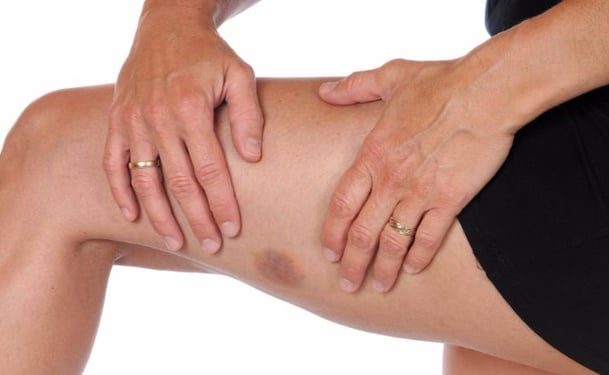Hemosiderin staining shows up in the lower legs as a dark purple or rusty discoloration on the skin. See what causes hemosiderin staining and how it's treated.
What is Hemosiderin Staining?
Hemosiderin staining occurs when red blood cells spill out of the smallest blood vessels (capillaries). Red blood cells contain hemoglobin, an iron-containing molecule that transports oxygen in your blood.
When the red blood cells die, iron released from the hemoglobin is converted into hemosiderin and stored in the tissue beneath the skin. This shows up as a brown stain on the skin.
The stain usually appears on the bottom part of the lower leg, but can also cover the entire area between the ankle and the knee. It can also darken over time and eventually may look black.
Causes of Hemosiderin Staining
Hemosiderin staining can occur in people with venous ulcers, which are slow-healing or non-healing wounds caused by blood pooling in the veins. It also shows up in people who have inflammation in the layer of fat beneath the skin of the lower legs (lipodermatosclerosis).
Hemosiderin staining can also occur after vein treatments like sclerotherapy or surface laser treatments. Most of the time, staining after these procedures will clear up on its own after a few months to a year.
However, hemosiderin staining due to venous ulcers or lipodermatosclerosis is unlikely to go away, although sometimes the color may lighten over time.
Treatment Options for Hemosiderin Staining
The best treatment for hemosiderin staining in these cases is early treatment of your venous ulcers or lipodermatosclerosis. This may keep the stain from growing darker. Sometimes the stain may lighten somewhat.
Surface laser and intense pulsed light (IPL) treatments may work in some cases, although it may only partially reduce the staining. These procedures can also be expensive.
Treatments for venous ulcers include:
- Compression therapy, such as elastic, inelastic and pneumatic
- Dressings to cover the wound
- Elevating the legs 30 minutes for three to four times each day
- Aspirin and other anti-clotting medications
- Antibiotics for skin infections
- Skin grafting
- Surgery for venous insufficiency, a condition in which the walls or valves in the legs are not working properly
Lipodermatosclerosis can also be treated with compression therapy to reduce the venous insufficiency. Other treatments include:
- Elevating the legs
- Avoiding sitting or standing for long periods
- Exercising regularly
- Maintaining a healthy weight
- Aspirin and other anti-clotting medications
- Vein surgery
Similar Conditions
Other conditions may have similar symptoms as hemosiderin staining, such as:
- Pigmented purpuric dermatoses (capillaritis): a chronic disease caused by leaky capillaries in the lower limbs. This causes deposits of hemosiderin in the tissues, which gives the skin a reddish-brown color. Some people also experience itching.
- Stasis dermatitis: this condition is caused by a pooling of fluids in the lower legs due to faulty valves in the veins or other circulatory problems. This can lead to discoloration of the skin on the ankles or shins, open sores, swelling and itching.
- Cellulitis: this bacterial skin infection causes the skin to look swollen and red. It often affects the skin on the lower legs, although it can occur anywhere on the body.


